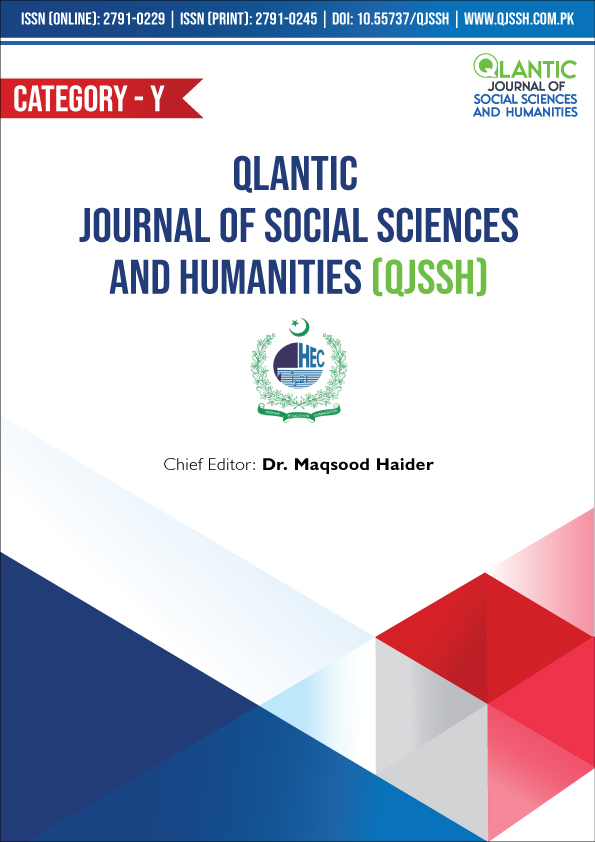Comparative Study of Cultural Influence on Mental Health Stigma among Pakistani Ethnic Groups
DOI:
https://doi.org/10.55737/qjssh.vi-i.25323Keywords:
Mental Health Stigma, Cultural Influence, Ethnic groups, Community Attitude Towards Mentally Ill, Negative Attitude, AwarenessAbstract
Pakistan, the fifth most populous country in the world and mental health is a most prevailing issue in the Pakistani society, as mental health care do not meet the needs of the population. Stigma related to mental health is also very common. Negative beliefs of people about those who have a mental illness are referred to as mental health stigma. The aim of this study is to examine the cultural influences on mental health stigma among young adults of different ethnic groups in Pakistan. A cross-sectional study in which the sample (N=200) comprised men (n=100) and women (n=100) university students within the age range of 18 to 25 years. The participants were selected from private and government sector universities in Islamabad and Rawalpindi. Public mental health stigma (MHS) is measured by the Community Attitude towards the Mentally Ill (CAMI; Taylor and Dear, 1981) scale consists of 40 items and four subscales. Results show that men have a more negative attitude towards mental health stigma, particularly in Baloch ethnicity, while women from Punjabi and Sindhi ethnicities have a more negative attitude, influenced by socioeconomic status. Findings help to reduce stigma associated with mental health and also help to design mental health stigma awareness programs to address these challenges in Pakistan. Potential limitations, suggestions, and implications of the study were also been discussed.
References
Abdullah, T., & Brown, T. L. (2011). Mental illness stigma and ethnocultural beliefs, values, and norms: An integrative review. Clinical Psychology Review, 31(6), 934-948. https://doi.org/10.1016/j.cpr.2011.05.003
Ahmad, S. S., & Koncsol, S. W. (2022). Cultural factors influencing mental health stigma: Perceptions of mental illness (POMI) in Pakistani emerging adults. Religions, 13(5), 401. https://doi.org/10.3390/rel13050401
Ayazi, T., Lien, L., Eide, A., Shadar, E. J., & Hauff, E. (2014). Community attitudes and social distance towards the mentally ill in South Sudan: A survey from a post-conflict setting with no mental health services. Social Psychiatry and Psychiatric Epidemiology, 49(5), 771-780. https://doi.org/10.1007/s00127-013-0775-y
Ciftci, A., Jones, N., & Corrigan, P. W. (2013). Mental health stigma in the Muslim community. Journal of Muslim Mental Health, 7(1). https://doi.org/10.3998/jmmh.10381607.0007.102
Corrigan, P. (2004). How stigma interferes with mental health care. American Psychologist, 59(7), 614-625. https://doi.org/10.1037/0003-066x.59.7.614
Corrigan, P. W., & Watson, A. C. (2007). The stigma of psychiatric disorders and the gender, ethnicity, and education of the perceiver. Community Mental Health Journal, 43(5), 439-458. https://doi.org/10.1007/s10597-007-9084-9
Corrigan, P. W., Larson, J. E., & Kuwabara, S. A. (2007). Mental illness stigma and the fundamental components of supported employment. Rehabilitation Psychology, 52(4), 451-457. https://doi.org/10.1037/0090-5550.52.4.451
Croot, E. J., Grant, G., Cooper, C. L., & Mathers, N. (2008). Perceptions of the causes of childhood disability among Pakistani families living in the UK. Health & Social Care in the Community, 16(6), 606-613. https://doi.org/10.1111/j.1365-2524.2008.00784.x
Falk, G. (2001). Stigma: How we treat outsiders. Amherst, N.Y: Prometheus Books.
Farooqi, Y. N. (2006). Traditional healing practices sought by Muslim psychiatric patients in Lahore, Pakistan. International Journal of Disability, Development and Education, 53(4), 401-415. https://doi.org/10.1080/10349120601008530
Finzen, A. (1996). Der Verwaltungsrat ist schizophren. Die Krankheit und das Stigma. Bonn: Psychiatrie-Verlag.
Gadit, A. A. M. (2007). Psychiatry in Pakistan: 1947-2006: A new balance sheet. JPMA, 57(9), 453-463.
Gaw, A. (1993). Culture, ethnicity, and mental illness. American Psychiatric Pub, Brown.
Gonzalez, J. M., Alegria, M., & Prihoda, T. J. (2005). How do attitudes toward mental health treatment vary by age, gender, and ethnicity/race in young adults? Journal of Community Psychology, 33(5), 611-629. https://doi.org/10.1002/jcop.20071
Grantham-McGregor, S., Cheung, Y. B., Cueto, S., Glewwe, P., Richter, L., & Strupp, B. (2007). Developmental potential in the first 5 years for children in developing countries. The Lancet, 369(9555), 60-70. https://doi.org/10.1016/s0140-6736(07)60032-4
Hinshaw, S. P. (2007). The mark of shame: Stigma of mental illness and an agenda for change. New York: Oxford University Press.
Husain, N., Chaudhry, I. B., Afridi, M. A., Tomenson, B., & Creed, F. (2007). Life stress and depression in a tribal area of Pakistan. British Journal of Psychiatry, 190(1), 36-41. https://doi.org/10.1192/bjp.bp.106.022913
Irfan, M. (2013). Integration of mental health in primary care in Pakistan. Journal of Postgraduate Medical Institute, 27(4), 349–351. https://jpmi.org.pk/index.php/jpmi/article/view/1573
Javed, A., Khan, M. S., Nasar, A., & Rasheed, A. (2020). Mental healthcare in Pakistan. Taiwanese Journal of Psychiatry, 34(1), 6. https://doi.org/10.4103/tpsy.tpsy_8_20
Leaf, P. J., Bruce, M. L., Tischler, G. L., & Holzer, C. E. (1987). The relationship between demographic factors and attitudes toward mental health services. Journal of Community Psychology, 15(2), 275-284. https://doi.org/10.1002/1520-6629(198704)15:2<275::aid-jcop2290150216>3.0.co;2-j
Link, B. G., & Phelan, J. C. (2001). Conceptualizing stigma. Annual Review of Sociology, 27(1), 363-385. https://doi.org/10.1146/annurev.soc.27.1.363
Mak, W. W. S., & Cheung, R. Y. M. (2008). Socio-cultural influences on mental health: The role of face in Chinese families. In Psychiatric and mental health nursing (pp. 249-264). Springer.
Marrow, J., & Luhrmann, T. M. (2012). The zone of social abandonment in cultural geography: On the street in the United States, inside the family in India. Culture, Medicine, and Psychiatry, 36(3), 493-513. https://doi.org/10.1007/s11013-012-9266-y
Mirza, I., & Jenkins, R. (2004). Risk factors, prevalence, and treatment of anxiety and depressive disorders in Pakistan: Systematic review. BMJ, 328(7443), 794. https://doi.org/10.1136/bmj.328.7443.794
Mirza, I., Mujtaba, M., Chaudhry, H., & Jenkins, R. (2006). Primary mental health care in rural Punjab, Pakistan: Providers, and user perspectives of the effectiveness of treatments. Social Science & Medicine, 63(3), 593-597. https://doi.org/10.1016/j.socscimed.2006.01.028
Niaz, U. (2004). Women's mental health in Pakistan. World Psychiatry, 3(1), 60–62.
Peacock, J. L. (1981). Durkheim and the social anthropology of culture. Social Forces, 59(4), 996. https://doi.org/10.2307/2577977
Razali, S. M., & Ismail, Z. (2014). Public stigma towards patients with schizophrenia of ethnic Malay: A comparison between the general public and patients’ relatives. Journal of Mental Health, 23(4), 176-180. https://doi.org/10.3109/09638237.2014.910644
Saeed, K., Gater, R., Hussain, A., & Mubbashar, M. (2000). The prevalence, classification and treatment of mental disorders among attenders of native faith healers in rural Pakistan. Social Psychiatry and Psychiatric Epidemiology, 35(10), 480-485. https://doi.org/10.1007/s001270050267
Sartorius, N. (2012). The stigma of mental illness. Oxford University Press.
Shafiq, S. (2020). Perceptions of Pakistani community towards their mental health problems: A systematic review. Global Psychiatry, 3(1), 28-50. https://doi.org/10.2478/gp-2020-0001
Shaikh, B. T., & Hatcher, J. (2005). Complementary and alternative medicine in Pakistan: Prospects and limitations. Evidence-Based Complementary and Alternative Medicine, 2(2), 139-142. https://doi.org/10.1093/ecam/neh088
Taj, R. (2016). Mental Health in Pakistan. In Routledge Handbook of Psychiatry in Asia. New York: Routledge/Taylor & Francis Group.
Tijhuis, M., Peters, L., & Foets, M. (1990). An orientation toward help-seeking for emotional problems. Social Science & Medicine, 31(9), 989-995. https://doi.org/10.1016/0277-9536(90)90108-5
Triandis, H. C. (1995). Individualism and Collectivism. Boulder: Westview Press.
Triandis, H. (1988). Collectivism v. individualism: A reconceptualisation of a basic concept in cross-cultural social psychology. In Cross-Cultural Studies of Personality, Attitudes and Cognition. London: Palgrave Macmillan, pp. 60–95.
Waqas, A., Zubair, M., Ghulam, H., Wajih Ullah, M., & Zubair Tariq, M. (2014). Public stigma associated with mental illnesses in Pakistani university students: A cross sectional survey. PeerJ, 2, e698. https://doi.org/10.7717/peerj.698
Weisman de Mamani, A., McLaughlin, M., Altamirano, O., Lopez, D., & Ahmad, S. S. (2020). Culturally informed therapy for Schizophrenia: A family-focused cognitive behavioral approach, clinician guide. https://doi.org/10.1093/med-psych/9780197500644.001.0001
Yousafzai, A. K., Obradović, J., Rasheed, M. A., Rizvi, A., Portilla, X. A., Tirado-Strayer, N., Siyal, S., & Memon, U. (2016). Effects of responsive stimulation and nutrition interventions on children's development and growth at age 4 years in a disadvantaged population in Pakistan: A longitudinal follow-up of a cluster-randomised factorial effectiveness trial. The Lancet Global Health, 4(8), e548-e558. https://doi.org/10.1016/s2214-109x(16)30100-0
Downloads
Published
Issue
Section
License
Copyright (c) 2025 Fiza Iman

This work is licensed under a Creative Commons Attribution-NonCommercial 4.0 International License.





